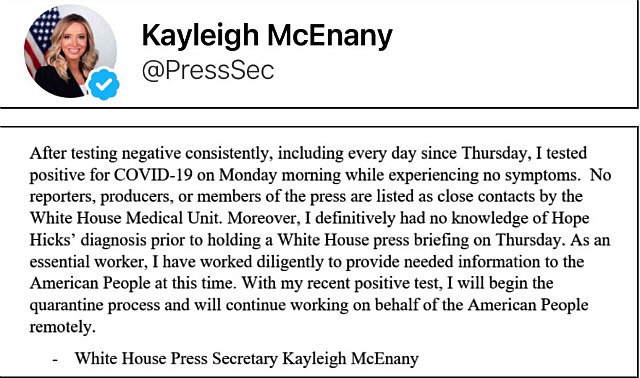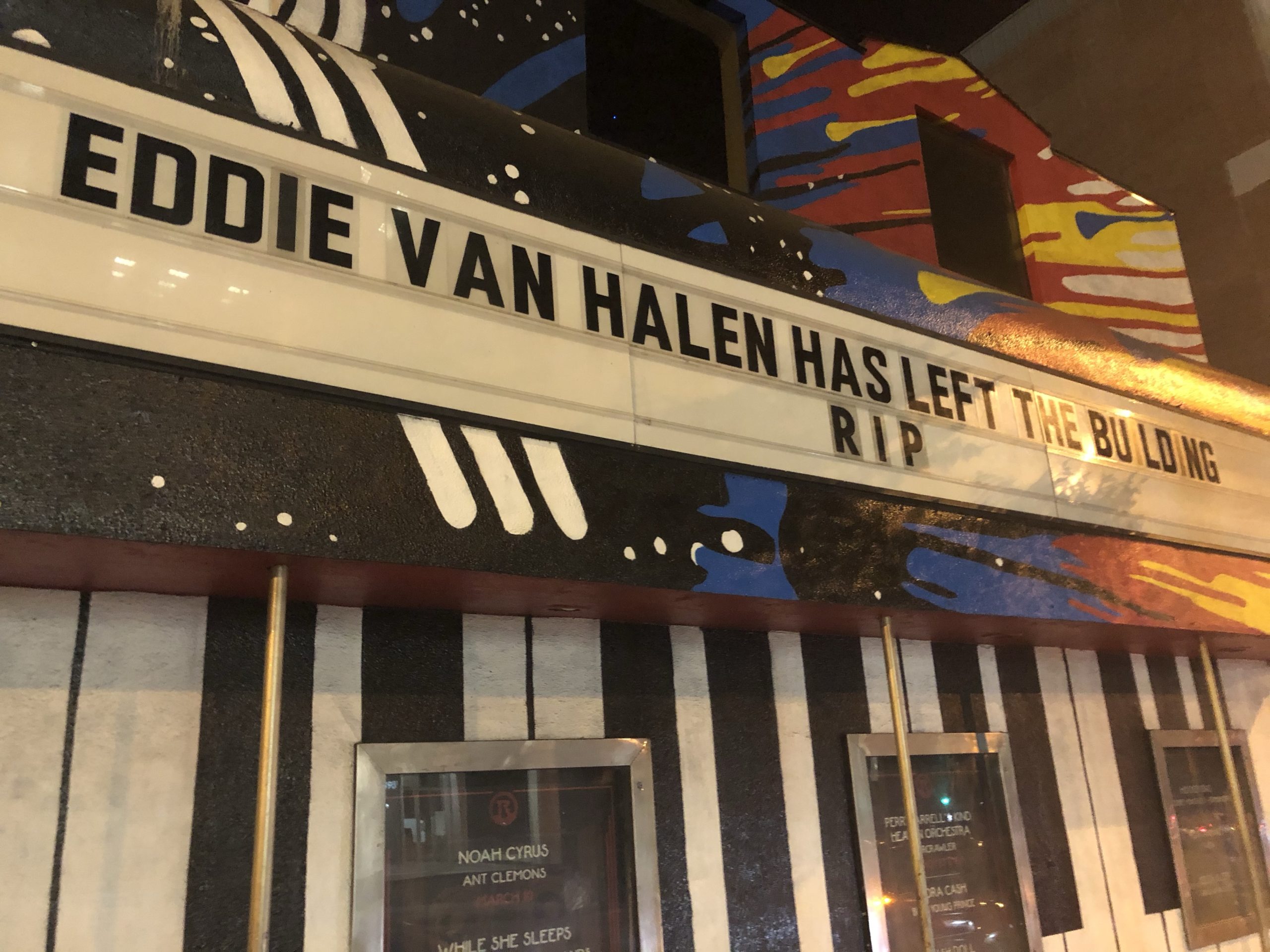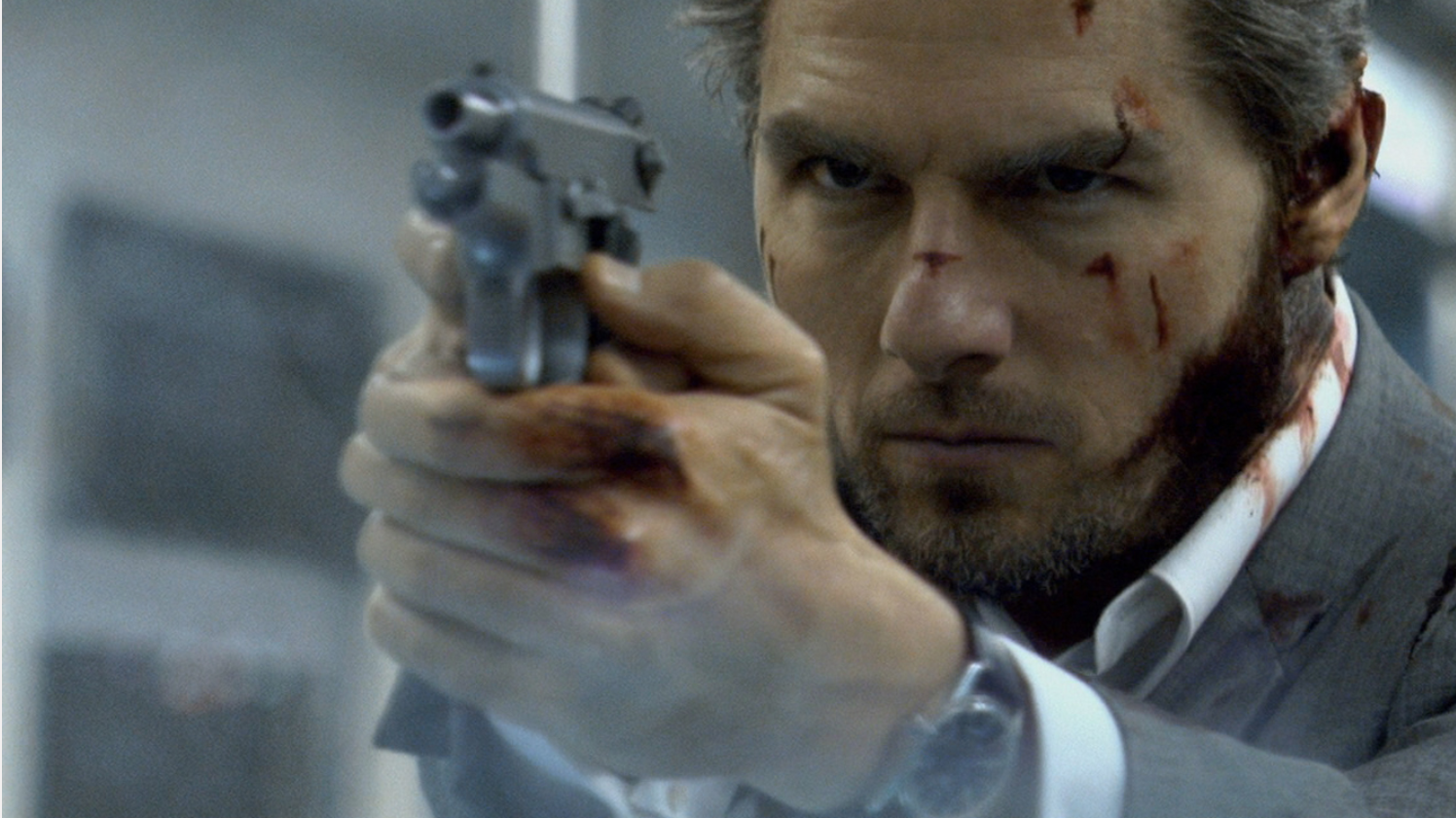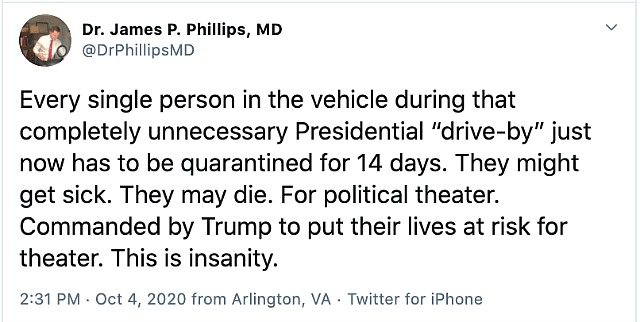If Donald Trump has truly jettisoned Covid-19 from his system, great. But based on what little I know about coronavirus coping, he could relapse any time over the next couple of weeks. Herman Cain, who’s the same age as Trump, was in and out with the disease (which he probably caught during Trump’s Tulsa rally) for three weeks before succumbing on 7.30.20.
 Jeffrey Wells
Jeffrey Wells
Van Hale and Farewell
Eddie Van Halen has passed at age 65. Due respect to a great rock guitarist and ’80s superstar. Condolences to friends, fans, family. Never saw the band live during the day. It is believed presumed that EVH’s decades-long embrace of the proverbial rock ‘n’ roll lifestyle had at least something to do with his relatively early departure.
What does Variety‘s Chris Willman have to say?
Rolling Stone‘s Andy Greene: “Eddie Van Halen, the legendary guitar innovator and virtuoso who led Van Halen through five decades and three lead singers, establishing himself as on the all-time great players in rock history, died Tuesday after a long battle with cancer. He was 65.”
Wiki: “Eddie was the main songwriter and founder — with brother and drummer Alex Van Halen, bassist Mark Stone, and singer David Lee Roth — of the American rock band Van Halen. In 2012, he was voted number one in a Guitar World magazine reader’s poll for “The 100 Greatest Guitarists of All Time”.
Wiki excerpts: “Valerie Bertinelli filed for divorce form EVH on 12.5.05 after four years of separation. The divorce was finalized in December 2007. Van Halen has struggled with alcoholism and drug abuse. He has stated that he began smoking and drinking at age 12, and that he eventually needed alcohol to function. Van Halen entered rehabilitation in 2007. In a 2015 interview, Van Halen stated that he had been sober since 2008. Van Halen married Janie Liszewski on 6.27.09. In August 2012, Van Halen underwent an emergency surgery for a severe bout of diverticulitis. It was revealed in 2019 that Eddie had been secretly battling throat cancer over the last five years.”
The Real Thing
I’ve sampled episode #1 of Darren Star‘s Emily in Paris. I realized soon after that the below Paris motorcycle-roam-around video is much more intriguing than Star’s 10-part Netflix series. Emily is pretty much exactly what you might expect from the creator of Beverly Hills 90210, Melrose Place, Sex and the City and Younger. It doesn’t matter what I think as I don’t represent the target audience, but there is so much more going on in that great aromatic symphony of a city than what Emily even tries to convey.
“The Batman” Bumped to 3.4.22
Earlier today and for months prior Matt Reeves‘ The Batman was slated to open on 10.1.21. This sounded reasonable and prudent. Who believes that the pandemic will be just as fierce and crippling a year from now? I don’t. A Covid vaccine will be available by…what, next February or March? How long will it take for U.S. citizens to be vaccinated? Three or four months? Five or six?
Anyway, today Warner Bros. announced that Reeves’ reboot will open theatrically on 3.4.22, or 13 and 1/2 months after Joe Biden‘s inauguration.
“Think Anybody’ll Notice?”
The person who designed the jacket cover for Paramount Home Video’s forthcoming Collateral 4K disc (12.8.20) got it wrong. Tom Cruise‘s “Vincent” doesn’t have a narrow dark beard of any kind. He sports a light 10-day growth…a salt-and-pepper thing that doesn’t begin to merit the “b” word.
The ending of Collateral is one of the most curiously moving I’ve ever seen. For an urban film in which a few guys get killed, I mean.


Glib CG Conceit
“This world is just a game but…”
It dawns upon “Guy” (Ryan Reynolds), a non-engaged video-game character, that he’s (a) living inside an action-packed video game and that (b) his world is also about to end. And so he’s determined to change his fate by making himself the hero, and then saving the game before the developers can shut it down. But he’s only a digital construct, of course, and not a part of any organic scheme so where could this possibly lead? Talk about a story with nowhere to go.
Peter Weir‘s The Truman Show (’98) was a somewhat similar fantasy. Jim Carrey played Truman Burbank, an innocent who’s grown up living within a large, dome-shrouded TV set populated by actors…a guy who knows nothing about life except for this fake, fascistic realm. Written by Andrew Niccol, The Truman Show would have had a fascinating third act if (a) Truman had escaped the dome only to be shocked by how sad and frustrating and hugely difficult real life is, and then (b) returned to the dome, suddenly grateful that he has a place to live that’s much less “happier” that what the real world allows.
Free Guy would be interesting if Reynolds and or two of his fellow characters could somehow become human. I doubt this is in the cards.
Directed by the dependably shallow Shawn Levy and cowritten by Matt Lieberman and Zak Penn, Free Guy (20th Century Studios) pops on 12.11.20.
I Find This Disorienting
In IFC Film’s Shithouse, director-writer Cooper Raiff plays a somewhat emotionally hindered college freshman named Alex. His problem is that he wears his heart too plainly on his sleeve and therefore isn’t aloof or blase enough. This becomes apparent when he scores with Maggie (Dylan Gelula), who feels weirded out by his morning-after sincerity. Or something in that realm.
My disorientation stems from the fact that Raiff is (a) good looking in a young Harry Hamlin sort of way, and (b) curiously rail thin. This goes against the Schlumpies & Dumpies aesthetic that began to take hold about five years ago…an anti-attractiveness aesthetic that argued with the decades-old Hollywood rule by which the guy who got the girl looked like the guy who got the girl.
Sometime during the Obama administration leading males began to look a little dweebier, a little thicker and pudgier, a little dorkier and a little beardier with pimples on their butt cheeks. Raiff doesn’t fit this paradigm — he actually looks attractive in the old-fashioned waspy-Warren Beatty-in-the-’60s-and-’70s sense. So I don’t get it. Is Raiff an outlier, or an indication of a new direction, a new vogue?
Shithouse, which won SXSW’s Grand Jury Award last March, will premiere in select theaters and on VOD on 10.16.20.
No One Will Come Near This Idiot
Orange Plague to U.S. Citizens: “Don’t be afraid of Covid…don’t let it dominate your life!”
What Trump means is that if you have the money, blue-chip insurance, power and high-level connections that allow access to the medical equivalent of “the kitchen sink“, which is what he’s been getting since Friday, and if you have those rugged German genes, you might resist the Covid embrace and leave the hospital after three days.
But he won’t be out of the woods for another 12 days if not 21. And only drooling morons will come within 20 feet of this douchebag, if that.
Three days ago Trump was treated with an 8-gram dose of the experimental antibody therapy cocktail made by the biotechnology company Regeneron. He also took doses of Remdesivir and Dexamethasone, not to mention zinc, vitamin D and other mild-mannered remedies.
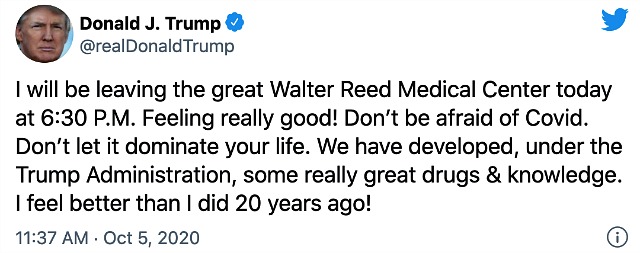

“Dune” Release Bumped A Full Year
Denis Villeneuve, Warner Bros. and Legendary Pictures’ Dune has totally and unsurprisingly caved to COVID and run screaming in the other direction. The 12.18.20 release has been scrapped — the sci-fi epic is now slated to open theatrically on 10.1.21. Does this mean Wonder Woman 1984>, which bumped its release date to 12.25.20 about three weeks ago, will also pull the plug and delay theatrical until sometime in ’21? Three guesses and the first two don’t count.
Love/Loathe “Tenet”
My theatrical viewing of Tenet a few weeks ago in a Flagstaff Harkins plex was a great thundering high. Big screen, booming sound, small buttered popcorn, extra-comfy rocking chair, first indoor viewing experience in over six months…mother!
Plus I wasn’t thrown by my all-but-complete inability to understand the particulars. (I’d absorbed the broad concepts in advance.) I knew going in that Tenet would defy understanding in the usual sense. I hate, hate, hate Nolan’s arrogant sound-design schemes. I couldn’t understand Tom Hardy‘s Bane, and I couldn’t understand half of Inception, and Interstellar, which I loathed from the very depths of my soul, was even worse. So I went into Tenet with an attitude of “go ahead, make my day…make it all but impossible to understand…I won’t care.” And I didn’t.
But time and again, as I mentioned in my 9.5.20 review, I was acknowledging that I’d never seen anything quite like this before. Excerpt: “I was smiling quizzically and a few times literally guffawing with pleasure. Tenet is all but impossible to fully ‘understand’ (certainly upon a first viewing, and even after reading the Wikipedia synopsis I was still going ‘wait, what?’) but my eyes, mind and expectations were constantly being challenged and blown. Pleasurably, of course.”
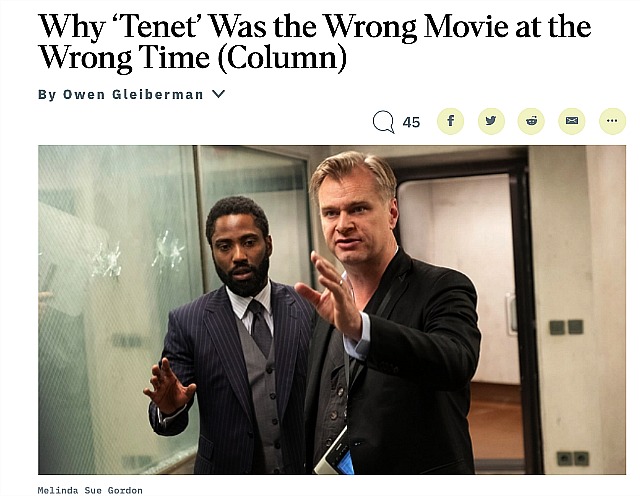
Yesterday Variety‘s Owen Gleiberman summed up this reaction as follows: “The film doesn’t entirely make sense, but that’s okay, because even when it doesn’t it’s such a bravura spectacle of head-spinning awesomeness (or something) that our heads are spun…sort of.” Yup, that was the reaction of Old Flagstaff Jeffie. And that’s what I’ll hang onto until a subtitled Bluray or the subtitled streaming version comes along, and then I’ll derive a whole new level of comprehension.
Gleiberman’s 10.4 column was titled “Why Tenet Was the Wrong Movie at the Wrong Time.” Here are some salient paragraphs and my corresponding reactions.
OG: “By the last act of Tenet, which is a grandiose action battle full of explosions that run backward (the sand funneling down into the earth, because those forces are moving in reverse), you can see that the effects are cool, and the idea is cool, but how the logistics of it all fit together remains barely coherent, which kind of limits the fun.” HE: “Yes, it’s curious and limiting, but I knew going in that Nolan was going to pull the same shit he did before.”
OG: “But what I discovered, to my surprise, is that Tenet, in all its high-toned kinetic quasi-obscurity, completed the alienation of the [oppressive COVID] experience. Rather than offering a great escape from the COVID blues, the movie was perfectly in sync with the COVID blues. Which is exactly what made it the wrong film for this moment.” HE: Disagree. Tenet rescued me from that climate of widespread depression outside the Harkin plex. For two and a half hours, I managed to forget the dull, dispiriting gloom of face masks, social distancing, no indoor restaurants, no flying to Europe, etc.
OG: “No, the reason that people are going to want to go back to the movies is joy. That’s what they want to feel; that’s the feeling that sitting at home can leach away. And Tenet, while marketed as a great escape, is a movie so tangled up in itself that it turned out to be as joyless an experience as the very prospect of going to see a movie during COVID.”
Kayleigh Joins Covid Crew
Punishment from God the Father Almighty for dishonorably spinning on behalf of Satan’s agent? Just desserts in my book.
